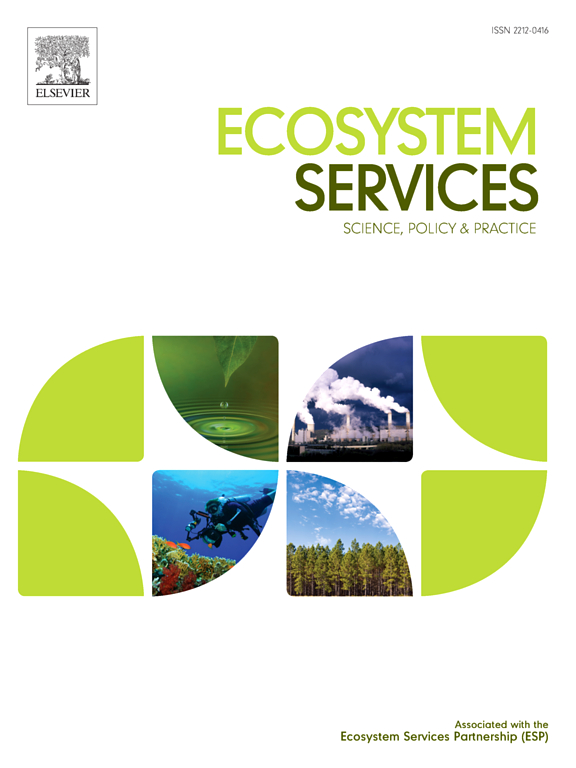各种水稻耕作制度的生态系统服务价值比较分析:中国的田间试验
IF 6.1
2区 环境科学与生态学
Q1 ECOLOGY
引用次数: 0
摘要
中国正在广泛采用水田综合耕作系统来解决水-食物-能源关系问题。人们已经对这些综合耕作系统的机理及其经济和生态效益进行了研究,但对其生态系统服务价值(ESV)的研究仍然有限。针对这一空白,本研究通过 2022 年早稻和晚稻生长季节的田间试验,比较分析了水稻单作、稻鱼共作和稻鱼蕹菜共作的生态系统服务价值。研究和评估了包括初级产品供应、二氧化碳固定、氧气释放、土壤有机质积累、防洪蓄水、土壤养分保持在内的六个正ESV和温室气体(GHG)排放在内的一个负ESV。稻-鱼-蕹菜共作的总正 ESV 最高,约为 50,200 美元/公顷/年,比水稻单作高出 31.4%,初级产品总价值比水稻单作增加了两倍多。稻鱼共作的总 ESV 约为 43,700 美元/公顷/年,比水稻单作的 38,200 美元/公顷/年高出 14.4%,初级产品总价值比水稻单作增加了 63%。减去温室气体排放的负值,稻鱼蕹菜共作的净 ESV 约为 49,400 美元/公顷/年,其次是稻鱼共作的 42,900 美元/公顷/年和水稻单作的 37,600 美元/公顷/年。我们的研究结果表明,应鼓励在稻田中采用良好的综合耕作系统,以获得更好的生态系统服务,并提高决策者和公众对生态农业的认识,同时应开展田间试验,探索更多实用的共作系统,实现经济效益、生态效益和生态系统服务功能的最优化和最大化。本文章由计算机程序翻译,如有差异,请以英文原文为准。
A comparative analysis of ecosystem service values from various rice farming systems: A field experiment in China
Integrated farming systems in paddy fields are being widely adopted for water-food-energy nexus in China. The mechanisms of these integrated farming systems and their economic and ecological benefits have been studied, however, investigation on their ecosystem service values (ESVs) remains limited in the field. To address this gap, this study comparatively analyzed the ESVs of rice monoculture, rice-fish co-culture and rice-fish-water spinach co-culture through a field experiment during the early and late rice growing seasons in 2022. Six positive ESVs including the primary product supply, CO2 fixation, O2 release, soil organic matter accumulation, flood control and water storage, soil nutrient maintenance, and one negative ESV of greenhouse gas (GHG) emissions were investigated and evaluated. The highest total positive ESV was approximately 50,200 US$/ha/yr of the rice-fish-water spinach co-culture, which was 31.4% higher than that of the rice monoculture, and the total primary products value increased by more than two folds than that of the rice monoculture. The total ESVs of the rice-fish co-culture resulted in approximately 43,700 US$/ha/yr, which was 14.4% higher than that of the rice monoculture of 38,200 US$/ha/yr, and the total primary products value increased by 63% as compared with the rice monoculture. Subtracting the negative value of GHG emissions, the net ESVs was approximately 49,400 US$/ha/yr of the rice-fish-water spinach co-culture, followed by 42,900 US$/ha/yr of the rice-fish co-culture, and 37,600 US$/ha/yr of the rice monoculture. Our findings suggested that it should be encouraged to adopt good integrated farming systems for better ecosystem services in paddy fields and to promote the decision makers’ and the public awareness on ecological farming, and field experiments are warranted to explore more practical co-culture systems and to optimize and maximize economic and ecological benefits as well as ecosystem service functions.
求助全文
通过发布文献求助,成功后即可免费获取论文全文。
去求助
来源期刊

Ecosystem Services
ECOLOGYENVIRONMENTAL SCIENCES&-ENVIRONMENTAL SCIENCES
CiteScore
14.90
自引率
7.90%
发文量
109
期刊介绍:
Ecosystem Services is an international, interdisciplinary journal that is associated with the Ecosystem Services Partnership (ESP). The journal is dedicated to exploring the science, policy, and practice related to ecosystem services, which are the various ways in which ecosystems contribute to human well-being, both directly and indirectly.
Ecosystem Services contributes to the broader goal of ensuring that the benefits of ecosystems are recognized, valued, and sustainably managed for the well-being of current and future generations. The journal serves as a platform for scholars, practitioners, policymakers, and other stakeholders to share their findings and insights, fostering collaboration and innovation in the field of ecosystem services.
 求助内容:
求助内容: 应助结果提醒方式:
应助结果提醒方式:


